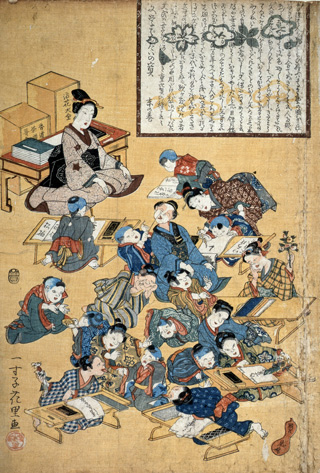
Kumon Museum of Children’s Ukiyo-e
A view of the cultural lifestyle of children from the Edo period
“Kumon Museum of Children’s Ukiyo-e” is a website that displays the collection of ukiyo-e (Japanese woodblock prints flourished mainly between the 18th and 19th centuries) depicting children and other cultural heritage collected by us, Kumon Institute of Education Co., Ltd.
Features of the “Kumon Museum of Children’s Ukiyo-e”

Mother and child with book in hand
Drawing inspiration from the efforts of a French historian Philippe Ariès, who pursued the study of children in medieval Europe by using paintings from that period, Kumon started building a collection of children’s ukiyo-e in 1986. The ukiyo-e prints, all thematically linked, vividly portray tender scenes of children being cherished as treasures by family members and people in the community, children being taken care of by their mothers, and children playing during various seasonal events.
Scholars of historiography, educational history, children’s culture, literature and ukiyo-e conducted research into children’s ukiyo-e to study the daily life of the common people during the Edo period (1603–1868) and Meiji period (1868-1712).
Children’s Education in the Edo Period

The work entitled “Learning is a treasure for generations”
During the Edo period, the literacy level of the average citizen in Japan was considered one of the highest in the world. The reason for this high level of education, according to one theory, was the existence of “Terakoya.” Terakoya schools were places where children learned the fundamentals of reading and writing, general ethical principles, and the basic knowledge required for their respective professions. Ukiyo-e prints of Terakoya schools illustrate children of all ages studying in the same room with an instructor providing individualized instruction using textbooks appropriate for each of the student’s current stage of progress.
Kumon has collected approximately 3,000 artifacts, including ukiyo-e, which depict child raising, education, and the type of play children engaged in from the Edo period onwards. Among the collection are textbooks, children’s illustrated books, and toys.We hope that our collection contributes to world peace by advancing the study of children’s culture.